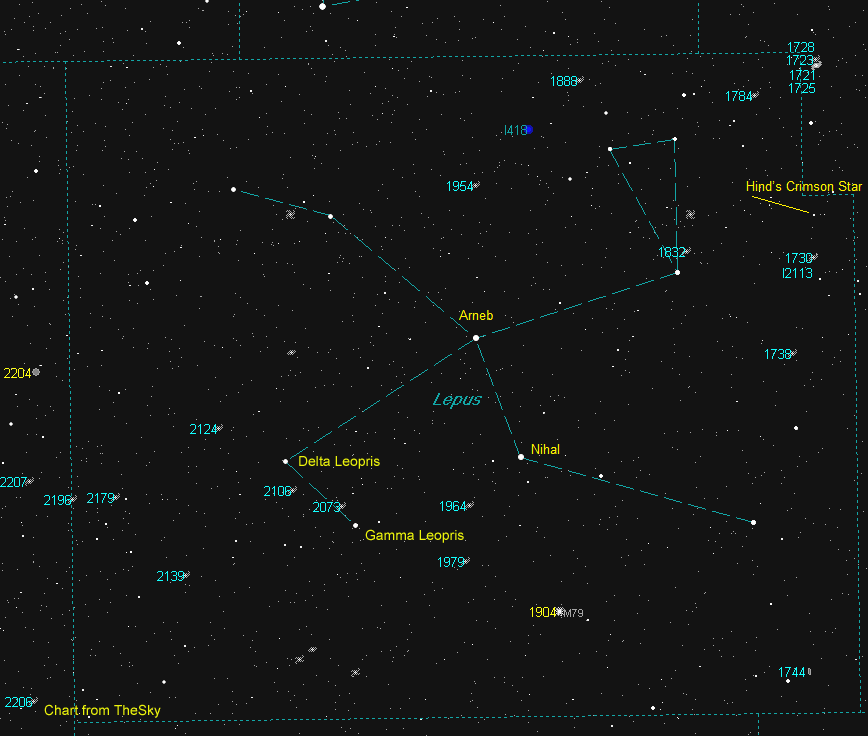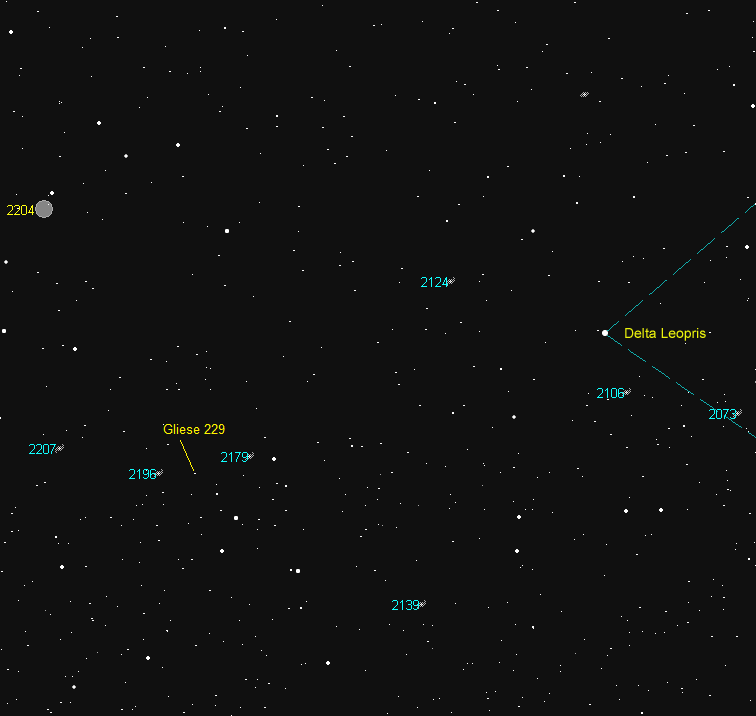Sky This Month – March, 2016
by Gary Boyle, RASC Ottawa Centre
Hunting The Hare
Last month we saw how mythology describes Orion as he battled Taurus the Bull. With shield and club in hand, it must have been a glorious match. However once a hunter always a hunter and if not taking on the mighty bull, he hunts Lepus the Hare. In the night sky, Lepus is located directly under the hunter and forms a stretched out letter “X”. Lepus takes up only 290 square of sky making it 51st in overall size. At the centre of the “X”, we find the alpha star named Arneb. This brilliant magnitude 2.58 star is a spectral class F0 with luminosity some 36,000 times that of our Sun and lies 2,200 light-years away. This brilliant sun might have a companion star but is most likely in line of sight or in front of Arneb.
Lepus is one of the original 48 constellations catalogued by Ptolemy in the 2nd century and is home to the famous variable star named R Leporis, commonly referred to as Hind’s Crimson Star. The star’s deep red colour is only seen around its minimum. Its overall range from magnitude 5.5 to 11.7 is completed in 418 to 441 days. However, there may be a secondary period of 40 years also to contend with. Hind’s Crimson Star is located very close to the border with the constellation Eridanus. It is hard to read about a constellation that is not home to at least one star with an exoplanet. Lepus does own one such star. Gliese 229 is an M1 star residing only 18.77 light-years away and has an orbiting planet with a mass 20 to 50 times that of the planet Jupiter.

M79 is a globular located 42,000 light-years away and is a bit of a mystery. Globular clusters usually appear close to the nucleus or halo of the Milky Way Galaxy. M79 is far from home or maybe not. Appearing slightly elongated in appearance, astronomers feel this object is a remnant globular cluster system of the Canis Major Dwarf galaxy; a dwarf galaxy that is now undergoing a very close encounter with the Milky Way. NGC 1888 is a small elongated galaxy measuring 3.2 X 1.2 arc minutes in size. This magnitude 11.9 teams up with NGC 1889 to make a nicely framed double galaxy.
There are numerous galaxies to hunt down and enjoy in Lepus but only one planetary nebula is found within its borders. IC418 dubbed the Spirograph Nebula from the similar artwork 1, 2, 3 produced from the popular drawing toy of the latter 1960s. IC418 measures 0.3 light-years wide and about 2,000 light-years from us, however, this distance is still uncertain. The outer shell of this dead star is expanding at a mere 12 kilometres per second.
The Messier Marathon is an all-night attempt to locate and observe all 110 Messier objects. Charles Messier (1730-1817) was a great comet hunter of his time. While comet hunting with his telescope, he came across the occasional “faint fuzzy” that turned out not to be a comet, no tail or motion. He decided to plot these on a star chart as a marker if ever he scanned the same area again. Because the Messier objects are distributed all over the sky, March 20 is the best chance to observe all as none are behind or around the Sun and its glare. There are three challenging objects to locate. First there the two galaxies M74 and M77 low in the west and hard to find in the dusk sky before they sink below the horizon. The third is the final object of the list, M30. Time is of the essence as we try to capture this globular cluster in the quickly brightening southeastern horizon. Unfortunately, the March full moon is on the 23rd. This means you will have to use the first or second week of March to find most of the Messier objects. Be sure to follow this list in order.

The planet Jupiter owns the night as it is at opposition on the 8th meaning it rises at sunset and sets at sunrise. This is also the point when the “King” of planets is closest to our planet. It also means some great photography of the Jovian cloud tops along with a few double shadow transits. A few highlighted this month involve the moons Io and Europa. Transit times are March 4 from 11:32 – 12:38 UT, March 8 from 00:28 – 1:56 UT and March 15 from 2:21 – 4:34 UT. For other transit timing please check page 232 of the RASC Observer’s Handbook 2016.
As the night moves on Mars is above the eastern horizon by 1 a.m. local time at the beginning of the month and is getting brighter. Presently at magnitude zero, the red planet gradually gets brighter until its opposition on May 22. A couple of hours later Saturn shows itself. We end off with brilliant Venus rising in the southeast at 6 a.m. Unfortunately, Mercury is reseeding into the solar glare.
The Vernal equinox occurs this year on March 20 at 4:31 UT. During both the spring and fall equinox, Earth is nicely lined up to witness the interstellar dust of our solar system. It is called the zodiacal light and is best seen from country skies and in the absence of the moon. This column of dust particles will be seen in the morning sky from the east and is angled. This sunlit dust rises about 40 degrees above the horizon. Start looking over the next two weeks starting from March 25. Photography would really help.
The new moon occurs on March 9 and the full Worm Moon occurs on the 23rd. A penumbral eclipse of the moon will also take place on the 23 starting at 5:39 a.m. eastern time. This type of eclipse will only turn the moon slightly darker. Don’t forget to advance your clocks to Daylight Saving Time on March 13 at 2 a.m. where applicable.
Until next month, clear skies everyone.
Twitter: @astroeducator
